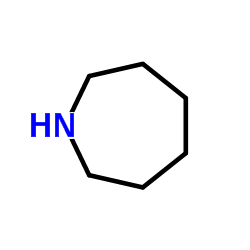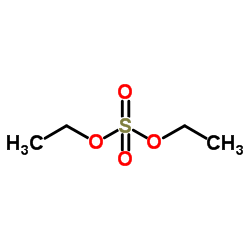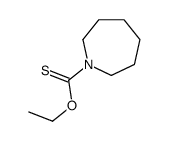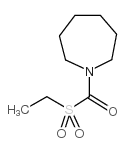2212-67-1
| Name | molinate |
|---|---|
| Synonyms |
UNII:68N5G08DJQ
Molmate Jalan EINECS 218-661-0 S-ethyl hexahydro-1H-azepine-1-carbothioate Sakkimol S-Ethyl 1-azepanecarbothioate S-Ethyl azepane-1-carbothioate S-ethyl perhydroazepine-1-carbothioate S-ethylhexahydro-1H-azepine-1-carbothioate S-ethyl perhydroazepine-1-thiocarboxylate Molinex S-ethyl-N,N-hexamethylene-thiocarbamate Higalnate Felan MFCD00055352 molinate Stauffer R 4572 Ordram 1H-Azepine-1-carbothioic acid, hexahydro-, S-ethyl ester S-Ethylazepan-1-carbothioat Hydram ethyl 1-hexamethyleneiminecarbothiolate |
| Density | 1.1±0.1 g/cm3 |
|---|---|
| Boiling Point | 279.0±23.0 °C at 760 mmHg |
| Molecular Formula | C9H17NOS |
| Molecular Weight | 187.302 |
| Flash Point | 122.6±22.6 °C |
| Exact Mass | 187.103088 |
| PSA | 45.61000 |
| LogP | 3.21 |
| Vapour Pressure | 0.0±0.6 mmHg at 25°C |
| Index of Refraction | 1.512 |
| Water Solubility | 0.08 g/100 mL |
|
Section1. IDENTIFICATION OF THE SUBSTANCE/MIXTURE Product identifiers Product name: Molinate CAS-No.: 2212-67-1 Relevant identified uses of the substance or mixture and uses advised against Identified uses: Laboratory chemicals, Manufacture of substances Section2. HAZARDS IDENTIFICATION Classification of the substance or mixture Classification according to Regulation (EC) No 1272/2008 [EU-GHS/CLP] Carcinogenicity (Category 2) Reproductive toxicity (Category 2) Acute toxicity, Inhalation (Category 4) Acute toxicity, Oral (Category 4) Specific target organ toxicity - repeated exposure (Category 2) Skin sensitization (Category 1) Acute aquatic toxicity (Category 1) Chronic aquatic toxicity (Category 1) Classification according to EU Directives 67/548/EEC or 1999/45/EC Limited evidence of a carcinogenic effect. Possible risk of impaired fertility. Harmful by inhalation and if swallowed. Harmful: danger of serious damage to health by prolonged exposure if swallowed. May cause sensitization by skin contact. Very toxic to aquatic organisms, may cause long-term adverse effects in the aquatic environment. Label elements Labelling according Regulation (EC) No 1272/2008 [CLP] Pictogram Signal wordWarning Hazard statement(s) H302Harmful if swallowed. H317May cause an allergic skin reaction. H332Harmful if inhaled. H351Suspected of causing cancer. H361fSuspected of damaging fertility. H373May cause damage to organs through prolonged or repeated exposure. H410Very toxic to aquatic life with long lasting effects. Precautionary statement(s) P273Avoid release to the environment. P280Wear protective gloves. P501Dispose of contents/ container to an approved waste disposal plant. Supplemental Hazardnone Statements According to European Directive 67/548/EEC as amended. Hazard symbol(s) R-phrase(s) R20/22Harmful by inhalation and if swallowed. R40Limited evidence of a carcinogenic effect. R43May cause sensitization by skin contact. R48/22Harmful: danger of serious damage to health by prolonged exposure if swallowed. R62Possible risk of impaired fertility. R50/53Very toxic to aquatic organisms, may cause long-term adverse effects in the aquatic environment. S-phrase(s) S36/37Wear suitable protective clothing and gloves. S46If swallowed, seek medical advice immediately and show this container or label. S60This material and its container must be disposed of as hazardous waste. S61Avoid release to the environment. Refer to special instructions/ Safety data sheets. Other hazards - none Section3. COMPOSITION/INFORMATION ON INGREDIENTS Substances Formula: C9H17NOS Molecular Weight: 187,3 g/mol ComponentConcentration Molinate CAS-No.2212-67-1- EC-No.218-661-0 Index-No.613-051-00-4 Section4. FIRST AID MEASURES Description of first aid measures General advice Consult a physician. Show this safety data sheet to the doctor in attendance. If inhaled If breathed in, move person into fresh air. If not breathing, give artificial respiration. Consult a physician. In case of skin contact Wash off with soap and plenty of water. Consult a physician. In case of eye contact Flush eyes with water as a precaution. If swallowed Never give anything by mouth to an unconscious person. Rinse mouth with water. Consult a physician. Most important symptoms and effects, both acute and delayed Diarrhoea, Weakness, Discomfort of the:, Stomach, Conjunctivitis. Indication of any immediate medical attention and special treatment needed no data available Section5. FIREFIGHTING MEASURES Extinguishing media Suitable extinguishing media Use water spray, alcohol-resistant foam, dry chemical or carbon dioxide. Special hazards arising from the substance or mixture Carbon oxides, nitrogen oxides (NOx), Sulphur oxides Carbon oxides, nitrogen oxides (NOx), Sulphur oxides Advice for firefighters Wear self contained breathing apparatus for fire fighting if necessary. Further information no data available Section6. ACCIDENTAL RELEASE MEASURES Personal precautions, protective equipment and emergency procedures Use personal protective equipment. Avoid breathing vapors, mist or gas. Ensure adequate ventilation. Evacuate personnel to safe areas. Environmental precautions Prevent further leakage or spillage if safe to do so. Do not let product enter drains. Discharge into the environment must be avoided. Methods and materials for containment and cleaning up Soak up with inert absorbent material and dispose of as hazardous waste. Keep in suitable, closed containers for disposal. Reference to other sections For disposal see section 13. Section7. HANDLING AND STORAGE Precautions for safe handling Avoid contact with skin and eyes. Avoid inhalation of vapour or mist. Conditions for safe storage, including any incompatibilities Store in cool place. Keep container tightly closed in a dry and well-ventilated place. Containers which are opened must be carefully resealed and kept upright to prevent leakage. Specific end uses no data available Section8. EXPOSURE CONTROLS/PERSONAL PROTECTION Control parameters Components with workplace control parameters Exposure controls Appropriate engineering controls Handle in accordance with good industrial hygiene and safety practice. Wash hands before breaks and at the end of workday. Personal protective equipment Eye/face protection Face shield and safety glasses Use equipment for eye protection tested and approved under appropriate government standards such as NIOSH (US) or EN 166(EU). Skin protection Handle with gloves. Gloves must be inspected prior to use. Use proper glove removal technique (without touching glove's outer surface) to avoid skin contact with this product. Dispose of contaminated gloves after use in accordance with applicable laws and good laboratory practices. Wash and dry hands. The selected protective gloves have to satisfy the specifications of EU Directive 89/686/EEC and the standard EN 374 derived from it. Body Protection Complete suit protecting against chemicals, The type of protective equipment must be selected according to the concentration and amount of the dangerous substance at the specific workplace. Respiratory protection Where risk assessment shows air-purifying respirators are appropriate use a full-face respirator with multi-purpose combination (US) or type ABEK (EN 14387) respirator cartridges as a backup to engineering controls. If the respirator is the sole means of protection, use a full-face supplied air respirator. Use respirators and components tested and approved under appropriate government standards such as NIOSH (US) or CEN (EU). Section9. PHYSICAL AND CHEMICAL PROPERTIES Information on basic physical and chemical properties a) AppearanceForm: liquid Colour: clear b) Odourno data available c) Odour Thresholdno data available d) pHno data available e) Melting point/freezingno data available point f) Initial boiling point and 355 °C at 1.013 hPa boiling range g) Flash point100 °C - closed cup h) Evaporation rateno data available i) Flammability (solid, gas) no data available j) Upper/lowerno data available flammability or explosive limits k) Vapour pressureno data available l) Vapour densityno data available m) Relative density1,060 g/cm3 n) Water solubilityno data available o) Partition coefficient: n-no data available octanol/water p) Autoignitionno data available temperature q) Decompositionno data available temperature r) Viscosityno data available s) Explosive propertiesno data available t) Oxidizing propertiesno data available Other safety information no data available Section10. STABILITY AND REACTIVITY Reactivity no data available Chemical stability no data available Possibility of hazardous reactions no data available Conditions to avoid no data available Incompatible materials Strong oxidizing agents Hazardous decomposition products Other decomposition products - no data available Section11. TOXICOLOGICAL INFORMATION Information on toxicological effects Acute toxicity LD50 Oral - rat - 369 mg/kg LD50 Dermal - rabbit - 3.536 mg/kg Skin corrosion/irritation no data available Serious eye damage/eye irritation no data available Respiratory or skin sensitization May cause allergic skin reaction. Germ cell mutagenicity Genotoxicity in vitro - Human - lymphocyte Cytogenetic analysis Genotoxicity in vivo - mouse - Oral Micronucleus test Carcinogenicity Limited evidence of carcinogenicity in animal studies IARC:No component of this product present at levels greater than or equal to 0.1% is identified as probable, possible or confirmed human carcinogen by IARC. Reproductive toxicity Suspected human reproductive toxicant Reproductive toxicity - rat - Inhalation Paternal Effects: Spermatogenesis (including genetic material, sperm morphology,motility, and count). Reproductive toxicity - rat - Oral Paternal Effects: Spermatogenesis (including genetic material, sperm morphology,motility, and count). Effects on Fertility: Male fertility index (e.g., # males impregnating females per # males exposed to fertile nonpregnant females). Effects on Newborn: Viability index (e.g., # alive at day 4 per # born alive). Reproductive toxicity - rat - Oral Effects on Fertility: Male fertility index (e.g., # males impregnating females per # males exposed to fertile nonpregnant females). Effects on Fertility: Post-implantation mortality (e.g., dead and/or resorbed implants per total number of implants). Developmental Toxicity - mouse - Intraperitoneal Specific Developmental Abnormalities: Urogenital system. Specific target organ toxicity - single exposure no data available Specific target organ toxicity - repeated exposure no data available Aspiration hazard no data available Potential health effects InhalationHarmful if inhaled. May cause respiratory tract irritation. IngestionHarmful if swallowed. Skin May be harmful if absorbed through skin. May cause skin irritation. EyesMay cause eye irritation. Signs and Symptoms of Exposure Diarrhoea, Weakness, Discomfort of the:, Stomach, Conjunctivitis. Additional Information RTECS: CM2625000 Section12. ECOLOGICAL INFORMATION Toxicity Toxicity to fishLC50 - Cyprinodon variegatus (sheepshead minnow) - 12 - 17 mg/l - 96,0 h Toxicity to daphnia and EC50 - Daphnia magna (Water flea) - 3,2 - 32,0 mg/l - 48 h other aquatic invertebrates Toxicity to algaeEC50 - Chlorella vulgaris (Fresh water algae) - 17,6 - 39,0 mg/l - 96 h Persistence and degradability Bioaccumulative potential BioaccumulationIctalurus punctatus - 13 d -1,33 µg/l Bioconcentration factor (BCF): 25 - 31 Mobility in soil no data available Results of PBT and vPvB assessment no data available Other adverse effects Very toxic to aquatic life. Section13. DISPOSAL CONSIDERATIONS Waste treatment methods Product Offer surplus and non-recyclable solutions to a licensed disposal company. Contaminated packaging Dispose of as unused product. Section14. TRANSPORT INFORMATION UN number ADR/RID: 3082IMDG: 3082IATA: 3082 UN proper shipping name ADR/RID: ENVIRONMENTALLY HAZARDOUS SUBSTANCE, LIQUID, N.O.S. (Molinate) IMDG: ENVIRONMENTALLY HAZARDOUS SUBSTANCE, LIQUID, N.O.S. (Molinate) IATA:Environmentally hazardous substance, liquid, n.o.s. (Molinate) Transport hazard class(es) ADR/RID: 9IMDG: 9IATA: 9 Packaging group ADR/RID: IIIIMDG: IIIIATA: III Environmental hazards ADR/RID: yesIMDG Marine pollutant: yesIATA: yes Special precautions for user Further information EHS-Mark required (ADR 2.2.9.1.10, IMDG code 2.10.3) for single packagings and combination packagings containing inner packagings with Dangerous Goods > 5L for liquids or > 5kg for solids. SECTION 15 - REGULATORY INFORMATION N/A SECTION 16 - ADDITIONAL INFORMATION N/A |
CHEMICAL IDENTIFICATION
HEALTH HAZARD DATAACUTE TOXICITY DATA
MUTATION DATA
|
| Symbol |



GHS07, GHS08, GHS09 |
|---|---|
| Signal Word | Warning |
| Hazard Statements | H302 + H332-H317-H351-H361-H373-H410 |
| Precautionary Statements | P201-P261-P273-P280-P304 + P340 + P312-P308 + P313 |
| Personal Protective Equipment | Eyeshields;Faceshields;full-face respirator (US);Gloves;multi-purpose combination respirator cartridge (US);type ABEK (EN14387) respirator filter |
| Hazard Codes | T,N,Xn |
| Risk Phrases | R20/22 |
| Safety Phrases | S36/37-S46-S60-S61 |
| RIDADR | 2902 |
| RTECS | CM2625000 |
| Packaging Group | III |
| Hazard Class | 6.1(b) |
| HS Code | 2933990017 |
| Precursor 7 | |
|---|---|
| DownStream 1 | |
| HS Code | 2933990017 |
|---|---|
| Summary | 2933990017 6,7-dihydrodipyrido[1,2-a:2',1'-c]pyrazine-5,8-diium bromide。supervision conditions:s(import or export registration certificate for pesticides)。VAT:17.0%。tax rebate rate:9.0%。MFN tarrif:6.5%。general tariff:20.0% |









